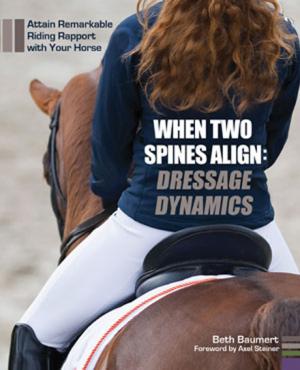By Peggy Gaboury
When I got to the USDF Convention this year, I was happy to see two big tables of books from Trafalgar Square Publishers. Recent conventions have not been graced by any of the big equine book publishers. For specialty books like that do not make the general book stores, it can be hard to learn about them.
Because the focus in my riding and teaching program is strongly on the influence of the rider’s seat (as opposed to the rider’s reins), my eyes jumped immediately to two books: When Two Spines Align: Dressage Dynamics by Beth Baumert and Rider and Horse Back to Backby Susanne von Dietze. I picked up my bag of newly acquired treasures and walked into one of the longer, more perfunctory meetings at the convention, and began to read.
There are books that you start to read and quickly find yourself thinking, “Oh, I need to underline that.” And then there is another place and another and another passage to be noted. This is one of those books! There is nothing here that is not important. The writing is clear, concise, and fresh. It is accessible to any reader, and makes sense even if you do not have a degree in bio-mechanics. If you have any interest at all in learning how to sit on your horse, in any discipline, in a way that maximizes the ability of the horse to carry you in comfort, this book will help you find your way.
In the first chapter, Beth writes, “Riders don’t usually realize when their undisciplined seats slosh, slide and shove. Some think that ‘using the seat’ means shoving every stride.” In the chapters that follow she describes the correct alignment of the rider’s seat to achieve a working balance with the horse’s movement. She gives exercises to help the rider develop the feel of being in the center of the horse’s movement, not above it or behind it or ahead of it. She describes the passive seat and then the active seat, and then continues on to the separation of the rider’s aids and their combination to achieve more advanced movements.
In dressage, we trainers are often guilty of “dressage speak.” We have more than a few phrases which we use among ourselves because we share a common understanding of what we mean by these words. But I have to admit that they make little or no sense to people outside the discipline. The book is full small insets, giving the definition concepts using the description in the dressage manuals, but at the same time breaking down that concept into pieces that build into an understanding of what that concept actually accomplishes, with respect to the balance of the horse. Half-halts, putting the horse in front of the leg, putting the horse on the bit, bringing the horse off the fore hand, are all examples of short phrases that often cause writers to engage in paragraphs of print. Beth avoids the pitfalls of long and wordy explanations by using pictures and diagrams to show the meaning of the concept. She gives many exercises that the rider can use to feel her way to understanding.
On almost every page, there are pictures with clear captions. Of great importance to me, the riders in the pictures uniformly demonstrate the balance and alignment that the book advocates. Far too often, I pick up a book that is well written and suggests good exercises, but the accompanying pictures show riders who are leaning behind the vertical and riding behind the movement. Here, there are no riders who are tense in their balance or loose in their seats; no horses who are over bent and behind the vertical. I hate it when I give a book to a student and have to tell her to ignore the pictures!
There is also a DVD that accompanies the book: How Riders Work: a guide to riding your horse in balance. This is the best presentation I have seen! I have shown this DVD to numerous students, and every one wants to take it home. But it’s not leaving my library, at least until those other copies I have ordered arrive. I am a very firm believer in the unconscious power of our minds – the motor neurons that record and rehearse movements that we see, which work even when we are sitting down and not actively participating. That being true, no one should spend time watching bad riders. This DVD is full of good riding! I make no apologies to my students for showing it, and they are encouraged to watch it over and over again. The information, like that in the book, is concise and well-organized. It is not a training manual for horses, but it is one for riders.
About the author: Beth Baumert trains horses and riders at Cloverlea Dressage LLC in Columbia, CT. She is a USDF Certified Instructor and was the first editor of Dressage Today. Beth has long been interested in rider education. Published by: Trafalgar Square Books. Visit: http://www.horseandriderbooks.com/
When I got to the USDF Convention this year, I was happy to see two big tables of books from Trafalgar Square Publishers. Recent conventions have not been graced by any of the big equine book publishers. For specialty books like that do not make the general book stores, it can be hard to learn about them.
Because the focus in my riding and teaching program is strongly on the influence of the rider’s seat (as opposed to the rider’s reins), my eyes jumped immediately to two books: When Two Spines Align: Dressage Dynamics by Beth Baumert and Rider and Horse Back to Backby Susanne von Dietze. I picked up my bag of newly acquired treasures and walked into one of the longer, more perfunctory meetings at the convention, and began to read.
There are books that you start to read and quickly find yourself thinking, “Oh, I need to underline that.” And then there is another place and another and another passage to be noted. This is one of those books! There is nothing here that is not important. The writing is clear, concise, and fresh. It is accessible to any reader, and makes sense even if you do not have a degree in bio-mechanics. If you have any interest at all in learning how to sit on your horse, in any discipline, in a way that maximizes the ability of the horse to carry you in comfort, this book will help you find your way.
In the first chapter, Beth writes, “Riders don’t usually realize when their undisciplined seats slosh, slide and shove. Some think that ‘using the seat’ means shoving every stride.” In the chapters that follow she describes the correct alignment of the rider’s seat to achieve a working balance with the horse’s movement. She gives exercises to help the rider develop the feel of being in the center of the horse’s movement, not above it or behind it or ahead of it. She describes the passive seat and then the active seat, and then continues on to the separation of the rider’s aids and their combination to achieve more advanced movements.
In dressage, we trainers are often guilty of “dressage speak.” We have more than a few phrases which we use among ourselves because we share a common understanding of what we mean by these words. But I have to admit that they make little or no sense to people outside the discipline. The book is full small insets, giving the definition concepts using the description in the dressage manuals, but at the same time breaking down that concept into pieces that build into an understanding of what that concept actually accomplishes, with respect to the balance of the horse. Half-halts, putting the horse in front of the leg, putting the horse on the bit, bringing the horse off the fore hand, are all examples of short phrases that often cause writers to engage in paragraphs of print. Beth avoids the pitfalls of long and wordy explanations by using pictures and diagrams to show the meaning of the concept. She gives many exercises that the rider can use to feel her way to understanding.
On almost every page, there are pictures with clear captions. Of great importance to me, the riders in the pictures uniformly demonstrate the balance and alignment that the book advocates. Far too often, I pick up a book that is well written and suggests good exercises, but the accompanying pictures show riders who are leaning behind the vertical and riding behind the movement. Here, there are no riders who are tense in their balance or loose in their seats; no horses who are over bent and behind the vertical. I hate it when I give a book to a student and have to tell her to ignore the pictures!
There is also a DVD that accompanies the book: How Riders Work: a guide to riding your horse in balance. This is the best presentation I have seen! I have shown this DVD to numerous students, and every one wants to take it home. But it’s not leaving my library, at least until those other copies I have ordered arrive. I am a very firm believer in the unconscious power of our minds – the motor neurons that record and rehearse movements that we see, which work even when we are sitting down and not actively participating. That being true, no one should spend time watching bad riders. This DVD is full of good riding! I make no apologies to my students for showing it, and they are encouraged to watch it over and over again. The information, like that in the book, is concise and well-organized. It is not a training manual for horses, but it is one for riders.
About the author: Beth Baumert trains horses and riders at Cloverlea Dressage LLC in Columbia, CT. She is a USDF Certified Instructor and was the first editor of Dressage Today. Beth has long been interested in rider education. Published by: Trafalgar Square Books. Visit: http://www.horseandriderbooks.com/








